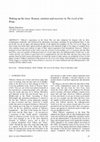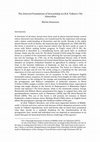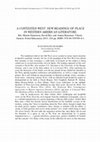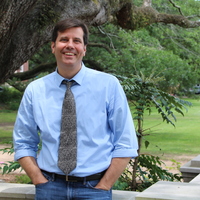Papers by Martin Simonson
Iberoamericana Vervuert eBooks, Dec 31, 2023
Iberoamericana Vervuert eBooks, Dec 31, 2023

CRC Press eBooks, Jun 9, 2022
Tolkien's experiences in the Great War not only enhanced his disgust with an ultratechnological m... more Tolkien's experiences in the Great War not only enhanced his disgust with an ultratechnological modernity and reinforced his apparently reactionary nostalgia for pre-industrial bliss; it also paved the way for an angry and eloquent literary revolt against the machines. In The Lord of the Rings, the trees awake and strike back against political oppression and industrial blight in the shape of vengeful Ents, who combine reason and emotion in spite of their radical separation from humankind. However, Tolkien's portrayal of trees and forests in this work is not one of misty-eyed nostalgia, nor is it escapist; just like Men and Elves, trees are capable of both good and evil. At the same time, the anthropocentric world-view is sub verted, and the very notion of good and evil is complicated by the fact that Ents and trees have their own agenda, based on both reason and emotion, in which the needs of other species are peripheral at best. In this paper, I look at Tolkien's portrayal of this process in The Lord of the Rings: from dormancy to an awakening, which triggers a response that in turn achieves a recovery of a more balanced and non-anthropocentric rela tionship with the natural world.
Los siguientes esbozos son extractos del libro Ovanliga Platser i Vitoria och Alava ( Lugares poc... more Los siguientes esbozos son extractos del libro Ovanliga Platser i Vitoria och Alava ( Lugares poco comunes en Vitoria y Alava ), un largo ensayo sobre la percepcion del espacio fisico y el poder del arte narrativo para manipularla. El observador es un periodista sueco que sigue las huellas de un explorador de su pais que desaparecio en los bosques de Izkiz a finales del siglo XIX.

English Studies in Africa, 2017
It is perhaps no surprise that trees should occupy the central stage in the dramatic unfolding of... more It is perhaps no surprise that trees should occupy the central stage in the dramatic unfolding of Tolkien's tales. In his Letters he makes several references to his particular love for trees-one frequently quoted instance of this is his claim that "I am (obviously) much in love with plants and above all trees and always have been; and find human maltreatment of them as hard to bear as some find ill treatment of animals", and on another occason he claims that "In all my works I take the part of trees as against all their enemies" ([1981] 2000, 220 and 419, respectively). Furthermore, in many of Tolkien's drawings, conceived as artistic accompaniments to his literary works, trees abound. In their pioneering study of Tolkien's achievements as an illustrator, J.R.R. Tolkien: Artist and Illustrator, Wayne G. Hammond and Christina Scull conclude that, apart from mountains, the predominating pictorial element in his art were trees, "with which he was even more enamoured. He incorporated them not only into dramatic forest scenes […] but also in quieter and more decorative pictures" (1998, 64). One of the drawings belonging to the latter category is entitled 'The Tree of Amalion' and Hammond and Scull (65) relate it to Tolkien's one allegorical tale, Leaf by Niggle, in which the author describes his own artistic endeavour as the painting of an ever-growing tree with leaves continuosly unfolding. My aim in this article, however, is not to highlight the correspondences between Tolkien's personal life and opinions and the depiction of trees in his literature and art. Rather I wish to focus on the mythical role of trees and forests in the process that defines the interconnected fate of Elves, Men, and the entire physical world, Arda, and to see how this fate is related to the ethical imperative of stewardship of the natural world in Tolkien's world. Most recent scholarship on nature in Tolkien's work-Brisbois (2005),

Zeitschrift für Anglistik und Amerikanistik, 2018
A common assumption about J.R.R. Tolkien’s works is that they are escapist, only dealing obliquel... more A common assumption about J.R.R. Tolkien’s works is that they are escapist, only dealing obliquely with issues related to the real world. This has been addressed in the field of literary studies by linking Tolkien’s literary output with twentieth-century concerns such as modernist practices and, in recent times, by reading his tales against the backdrop of ecocriticism. However, scholars in the latter field, such as Dickerson, Evans, and Campbell, frequently over-emphasize wonder and the spiritual connection with the natural world as the intended response of readers, which undermines the potential implications and relevance of Tolkien’s works for the real world. In this article I wish to show that Tolkien’s cosmological vision is not only premised on the idea of appreciating the wonder-inciting qualities of the world but that it also entails a certain amount of utilitarianism, and the need to combine both is related to the ethical theory of ideal utilitarianism as outlined by G.E. M...
Multiple Voices in Academic and Professional Discourse Current Issues in Specialised Language Research Teaching and New Technologies 2011 Isbn 9781443829717 Pags 645 652, 2011
Un Mundo Muchas Miradas, Jun 29, 2011
Profesor de sueco Resumen Los siguientes esbozos son extractos del libro Ovanliga Platser i Vitor... more Profesor de sueco Resumen Los siguientes esbozos son extractos del libro Ovanliga Platser i Vitoria och Álava (Lugares poco comunes en Vitoria y Álava), un largo ensayo sobre la percepción del espacio físico y el poder del arte narrativo para manipularla. El observador es un periodista sueco que sigue las huellas de un explorador de su país que desapareció en los bosques de Izkiz a finales del siglo XIX. Laburpena Lehen lerro hauek Ovanliga Platser i Vitoria och Álava (Gasteiz eta Arabako ezohiko tokiak) lanetik ateratako laburpenak dira. Liburua saiakera luze bat da, espazio fisikoaren pertzepzioa eta arte narratiboak berori manipulatzeko duen ahalmenari buruzkoa. Behatzailea kazetari suediar bat da, XIX. mende amaieran Izkizeko basoetan desagertu zen bere herrialdeko esploratzaile baten arrastoen atzetik dabilena.
Primeras Noticias Revista De Literatura, 2007
Zeitschrift für Anglistik und Amerikanistik, 2017
In J. R. R. Tolkien’s tales set in the fictional region of Beleriand, the paradox of a union betw... more In J. R. R. Tolkien’s tales set in the fictional region of Beleriand, the paradox of a union between immortal and mortal beings, and all that this dichotomy implies, is consistently reflected in wooded settings. At the same time, we can also discern a general direction, which will eventually bring both Elves and Men out of the dark woods and into the light in a symbolical process of enlightenment. However, the woods in the tales reflect both pitfalls and promises, making it impossible to interpret this natural environment as unequivocally positive or negative, but a mixture of both. Tolkien’s stance towards trees and forests can thus be seen as realistic rather than escapist in these tales.

Interdisciplinary Studies in Literature and Environment, 2014
The traditional field of the Old West never seemed to attract much attention in Spanish academia.... more The traditional field of the Old West never seemed to attract much attention in Spanish academia. Luckily, the rise of the paradigm of the New West has altered that anomaly so that, nowadays, a solid body of research on the subject is being carried out in several universities all over Spain. The leading exponent of this new scenario is David Río, who teaches U.S. Literature at the University of the Basque Country, and is one of the three editors of A Contested West. After exp loring for years the intricacies of the South, over the last decade he has shifted his attention to the West, putting together conferences and publications, as well as a major research project. He is also behind an unusual project in Spanish academic circles: creat ing a book series, 'American Literary West', with an editorial board formed by names as distinguished in the field as Fran k Bergon, Neil Campbell, Richard W. Etulain, Maria Herrera-Sobek, or Peter Hulme. Three essay collections on the multip le identities of West have been published in only three years: Beyond the Myth. New Perspectives on Western Texts (2011), The Neglected West. Contemporary Approaches to Western American Literature (2012), and now, A Contested West. New Readings of Place in Western American Literature (2013). Like its predecessors, the third volume offers challenging and insightful views on the West. Even the cover departs from the traditional iconograply, since it is a colorful reproduction of a poster depicting a Chicana field wo rker. Author Rick Bass pens a brief but densely lyrical introduction on the ineffable essence of the territory, noting that "there is something about the West which, though it might thus far elude precise capture, nonetheless exists, thrums, is redolent with the abilit y, it seems, to both generate and receive deep emotion" (iv), words which bring to mind The Great Gatsby. He also adds the suggestive notion that, most likely, the art and the literature of a space as vast as the West are characterized by "a greater imaginativeness, [.. .] greater loneliness, greater joys, greater volatilit ies of weather and the seasons" (vi). Many of the essays in the collection do move in this direction,
Intelligence, Creativity and Fantasy, 2019
By a lady: estudios sobre Jane Austen, 2017, ISBN 978-84-16477-58-6, págs. 213-226, 2017

Intelligence, Creativity and Fantasy, 2019
In this paper, I argue that the tension between tradition and modernity which operated upon the m... more In this paper, I argue that the tension between tradition and modernity which operated upon the mind of many writers in the early twentieth century was frequently articulated around the dichotomy between the city and the country. As in the Romantic period a hundred years earlier, the "country" was associated with autochthonous cultural traditions, folklore, myth and imagination, and seen as a place of escape from a dreary and prosaic industrialised reality. For many writers of the Edwardian period, the countryside turned into a liminal space capable of hosting the presence of both imagination and reason, myth and realism, the native and the foreign, safety and threat. This is frequently seen in the works of Edward Thomas, Arthur Machen and Algernon Blackwood, who each in his own way, and with different results, negotiated the liminal space between the Edwardian everyday reality and the potentially wonder-inspiring world of nature, with its half-hidden historical, mythical and supernatural depths, lurking at the very borders of perception.
Tradition and Innovation, 2021











Uploads
Papers by Martin Simonson